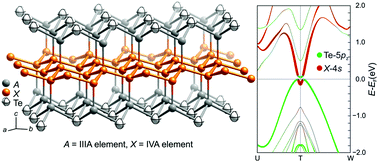Designing 3D topological insulators by 2D-Xene (X = Ge, Sn) sheet functionalization in GaGeTe-type structures†
Abstract
State-of-the-art theoretical studies anticipate a 2D Dirac system in the “heavy” analogues of graphene, free-standing buckled honeycomb-like Xenes (X = Si, Ge, Sn, Pb, etc.). Herewith we regard a 2D sheet, which structurally and electronically resembles Xenes, in a 3D periodic, rhombohedral structure of layered AXTe (A = Ga, In; X = Ge, Sn) bulk materials. This structural family is predicted to host a 3D strong topological insulator with Z2 = 1;(111) as a result of functionalization of the Xene derivative by covalent interactions. The parent structure GaGeTe is a long-known bulk semiconductor; the “heavy”, isostructural analogues InSnTe and GaSnTe are predicted to be dynamically stable. Spin–orbit interaction in InSnTe opens a small topological band gap with inverted gap edges that are mainly composed of the In-5s and Te-5p states. Our simulations classify GaSnTe as a semimetal with topological properties, whereas the verdict for GaGeTe is not conclusive and urges further experimental verification. The AXTe family structures can be regarded as stacks of 2D layered cut-outs from a zincblende-type lattice and are composed of elements that are broadly used in modern semiconductor devices; hence they represent an accessible, attractive alternative for applications in spintronics. The layered nature of AXTe should facilitate the exfoliation of their hextuple layers and manufacture of heterostructures.



 Please wait while we load your content...
Please wait while we load your content...